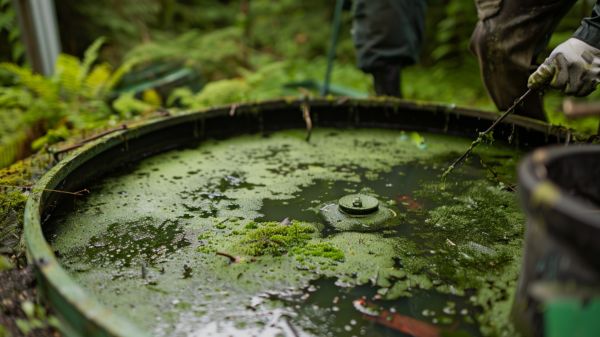Aerobic septic system frequently faces issues such as power supply failures, clogs, low air pressure, and broken timers. To fix power problems, make sure the system is turned on, check breaker status, and consider a backup generator. Regularly clean chlorinators and inspect tubes for clogs to prevent blockages.
Check the air compressor and pipes to address low air pressure. Use diagnostic tools like a multimeter for timer repairs, verifying all connections are secure. Routine maintenance, such as inspecting pumps and limiting water usage, helps prevent system damage and improve longevity. Discover more solutions and maintenance strategies for lasting performance.
💧 Eco-Friendly Septic Care, Simplified.
Most eco-homes forget the hidden half of sustainability — what happens after you flush. Septifix uses oxygen-releasing bacteria to naturally break down waste, remove odors, and keep groundwater clean — without harsh chemicals or costly pumping. 🌿
→ Discover Septifix Here
Key Takeaways
- Regularly inspect and clean chlorinators to prevent blockages and maintain proper chlorine levels in the system.
- Conduct routine checks on air compressors to ensure sufficient oxygen supply and system efficiency.
- Maintain consistent power supply to avoid disruptions in aerobic treatment processes and prevent odor issues.
- Perform sludge pumping every 2-3 years to prevent buildup and maintain system functionality.
- Monitor and address high water usage to prevent system overload and potential drain field damage.
Power Issues Resolution
To effectively resolve power issues in aerobic septic systems, you’ll first want to make sure the system’s power supply is both on and functioning correctly. This involves confirming the power switch is engaged and checking that the breaker hasn’t been tripped.
Power management is essential; ensuring the efficient flow of electricity will help keep your system operating smoothly. Begin by inspecting electrical components such as timers and air pumps. Malfunctions here can cause significant disruptions. Examine these components with an eye for energy efficiency, replacing faulty parts to boost overall system performance.
You should also reset the control panel as needed to clear any alarms and reprogram the timer. In aerobic septic systems, the efficiency in removing wastewater contributes to a reduced environmental impact—less contamination and safer ecosystems. As part of the power management strategy, inspect submersible pumps, checking for clogs or damage.
Malfunctioning pumps might cause backups or overflows, leading to more problems. Additionally, if power outages are a concern, consider investing in backup generators. This power management tool is invaluable during emergencies, ensuring your system remains energy efficient and operational.
Regular inspections are your ally. They can catch potential issues early, allowing you to belong to the group of proactive septic system owners who enjoy fewer disruptions and more peace of mind.
Fixing Clogged Chlorinators
When tackling clogged chlorinators, regular maintenance is essential to keep your system running smoothly. Cleaning the chlorinator every 1-3 months not only prevents blockages but also extends its lifespan. Incorporating septic chlorinating tablets as recommended ensures that the chlorinator functions effectively without causing further issues.
Regular inspections of the entire septic system can also help identify potential problems before they escalate, ensuring the chlorinator and other components continue to operate efficiently. Follow safe cleaning methods to remove debris and buildup, ensuring the chlorinator functions effectively without causing further issues.
Regular Maintenance Tips
For effective aerobic septic system maintenance, fixing clogged chlorinators is essential to guarantee ideal operation. You’ll need to keep an eye on your chlorinator through routine checks. Start by inspecting it regularly for debris buildup and utilize preventative strategies like installing a check valve to stop backflow and debris accumulation.
Pay special attention to the Penta Rainbow 320 model, which is known for its susceptibility to clogs at the check valve. Ensuring the proper installation of the chlorinator can go a long way in minimizing clog risks, and sticking to these steps will keep your system running smoothly.
Pay attention to signs of clogged chlorinators, as these can manifest through system alarms or a noticeable decline in chlorine output and efficiency. Inspect the tubes and hoses for any blockages, and use diagnostic tools to detect any clogs efficiently.
Don’t ignore signs of increased pressure or flow restrictions, as these can be early indicators of trouble.
When it’s time to fix a clog, turn off the power supply first. Disconnect and clean any clogged check valves carefully, making sure not to damage the plastic parts. Reassemble everything and test the system.
This way, you maintain your aerobic septic system’s health and contribute to the community’s wellbeing.
Safe Cleaning Methods
While you tackle the task of fixing clogged chlorinators in aerobic septic systems, using safe cleaning methods is vital. It’s important to choose septic friendly products that won’t harm the system or its beneficial bacteria.
Consider using natural cleaners like distilled white vinegar and baking soda, both effective and septic-safe options. These natural cleaners not only help dislodge blockages but also maintain the balance of bacteria essential for the system’s efficiency. Healthy bacterial levels are crucial because they play a significant role in breaking down solid waste, ensuring the septic system operates properly.
Regular inspection is key to preventing clogs. Check your chlorinator for any debris build-up, guaranteeing it runs smoothly. When cleaning, Epsom salt or lemon juice can be used to gently remove blockages without disrupting the system.
Avoid products like chlorine bleach or crystal drain cleaners; these can kill beneficial bacteria and lead to system failure. Always use cleaning products in limited quantities. Excessive use, even of safe products, can cause issues.
Follow the product directions carefully to avoid creating harmful chemical reactions. Maintaining regular maintenance checks on your system guarantees it operates efficiently. If you notice persistent issues, consider professional repair or investing in backup systems.
Your commitment to these practices fosters a well-functioning system and a sense of community care.
Submersible Pump Solutions
Tackling submersible pump problems head-on guarantees your aerobic septic system functions smoothly. Start by evaluating the pump performance with proper troubleshooting techniques.
Regular inspections can reveal issues such as bad wiring or a faulty float, both of which might cause irregular operation. Monitoring the system’s inputs provides insights into potential problems, which aids in proactive troubleshooting.
Listening for unusual noises and checking for backflows or overflows can help you spot trouble early. If the pump doesn’t turn on or water levels remain unchanged, it’s time to take action. Consider these solutions to guarantee your pump operates effectively:
- Repair and Replacement: Check for wear and replace the pump if needed. Installing a backup pump can prevent disruptions during emergencies.
- Proper Installation: Ensure the pump is installed correctly to avoid preventable failures.
- Wiring and Components Check: Regularly inspect wiring and floats for problems.
To prevent future issues, maintain a routine of pump inspections following the manufacturer’s guidelines.
Monitoring your system’s water use also plays a role in safeguarding against overloading. By keeping an eye on these aspects and seeking help from certified professionals when necessary, you’ll foster a reliable and smoothly running septic system, reinforcing your rightful place within your community of informed septic system caretakers.
💧 Eco-Friendly Septic Care, Simplified.
Most eco-homes forget the hidden half of sustainability — what happens after you flush. Septifix uses oxygen-releasing bacteria to naturally break down waste, remove odors, and keep groundwater clean — without harsh chemicals or costly pumping. 🌿
→ Discover Septifix Here
Addressing Low Air Pressure
As aerobic septic systems age, addressing low air pressure becomes vital to maintain peak performance. You’ll want to guarantee your system functions smoothly to feel part of a community that cares for their environment.
Start by identifying the causes of low air pressure. Broken or clogged pipes can impede airflow, and clogged filters might disrupt the entire system. The aerator functionality is critical, as blockages here can greatly reduce air pressure.
Don’t overlook the intake valve, which might cause trouble if it’s not operating correctly. Even a failing air compressor could hinder oxygen supply effectively. Insufficient air pressure can particularly undermine the system’s functionality, highlighting the need for regular checks and timely intervention.
When diagnosing, inspect the pipes and filters for blockages or damage. Check if the aerator is working as it should and verify the air compressor’s condition. Bad intake valves can be a silent disruptor.
Also, a clogged chlorinator might indirectly affect air pressure, so keep an eye on the system’s alarm for warnings.
Solutions include repairing or replacing malfunctioning components like pipes and filters. Guarantee thorough cleaning or replacement of bad intake valves and routine aerator maintenance to guarantee proper functionality.
Adhering to a strict maintenance schedule prevents these issues from escalating and keeps your system in harmony with nature.
Repairing Broken Timers
When facing broken timers in your aerobic septic system, start by identifying the problem through careful inspection. Many systems operate using float switches rather than timers, so it’s important to first determine if your system type relies on a timer for its operations.
Use tools like a volt meter to check for current and guarantee the system’s power supply is functioning correctly. Once you’ve pinpointed faulty components, such as the timer or float switches, replacing them and resetting the system according to the manufacturer’s guidelines will restore proper operation.
Identifying Timer Problems
Identifying and repairing broken timers in aerobic septic systems can often seem intimidating, yet it’s an essential skill to guarantee proper system performance. The primary issues to look for include timer calibration issues and electrical component failures. When your system exhibits unusual sprinkler operation or doesn’t turn off as scheduled, these symptoms typically point to timer problems.
Power interruptions affecting the timer clock motor often trigger inconsistent functionality. Moreover, the Intermatic FM/1 timer, designed to control irrigation sprinkler systems, is known for its role in On-Site Sewage Facilities (OSSF) and can experience similar malfunctions when power is inconsistent. Symptoms like incorrect wastewater dispensing and alarm triggers can arise from timer malfunctions.
To diagnose such timer issues, begin by checking the power supply and connections. Inspect the timer for wear, damage, and verify its settings along with calibration accuracy. It’s vital to confirm that the electrical components aren’t faulty, as well.
Additionally, you should:
- Verify the override float switch functions properly.
- Test for any blown breakers or electrical issues.
- Confirm grounding and consistency in power supply.
Tools for Timer Repair
Repairing broken timers in aerobic septic systems requires a set of specific tools that guarantee you can accurately diagnose and address any issues. To start, a multimeter is indispensable for measuring voltage, allowing you to confirm that the timer is receiving the correct power. This tool also plays a key role in wiring inspection, helping to detect any faulty connections.
In some cases, correctly identifying a faulty float switch can prevent further damage to the system. Equipped with a wiring diagram, you’ll understand the electrical layout, which is essential when inspecting and troubleshooting timer issues. Screwdrivers are necessary for accessing the control panel and other timer components, while pliers come in handy for gripping and adjusting small parts during repairs.
Don’t forget to use safety gloves to shield yourself from potential shocks. For more precise adjustments, timer calibration tools guarantee the settings are correct, preventing malfunctions.
Inspecting the wiring is an important step. Look for any damage or incorrect connections, which can be resolved with the right tools and knowledge. Make sure you’ve turned off the power to avoid hazards.
Consulting user manuals is beneficial, offering detailed guidance for your specific timer model. With the right tools and approach, you’ll maintain a reliable aerobic septic system.
Replacing Faulty Components
Although dealing with a broken timer in your aerobic septic system can be challenging, knowing the steps to replace faulty components can streamline the process. Timers play a vital role in guaranteeing efficient operation by managing dosing cycles accurately.
Understanding timer features and acknowledging maintenance importance can prevent early failures caused by electrical faults, mechanical wear, or incorrect installations. If your timer shows signs of malfunction, such as the effluent pump not activating on schedule or system alarms frequently sounding, it’s time to replace it.
A key function of aerobic treatment unit control panels, such as the E4L Panel, is to ensure the precise control of pump timing to optimize system operation and prevent flooding. Here’s a streamlined approach to replacing a faulty timer:
- Identify the Timer Type: Determine if you need a clock or dosing timer for compatibility with your system.
- Guarantee Safety: Turn off the power supply to the control panel for safe disconnection of the old timer.
- Install Correctly: Follow the manufacturer’s instructions for wiring to guarantee correct functionality.
Regular maintenance checks are essential to catching potential issues early. Make it a habit to inspect the timer and its connections for wear.
Setting up a consistent maintenance routine will guarantee your aerobic septic system continues to run smoothly, exemplifying the maintenance importance in extending the life of your components.
Identifying Alarm Causes
Alarms in aerobic septic systems can be unsettling, often signaling underlying issues that need immediate attention. It’s essential to understand the causes and prepare for tank inspections to guarantee your aerobic systems function smoothly.
One common reason for alarms is no power or electrical issues. Accidentally turning off the power switch or a tripped power breaker can trigger the system alarm, signaling that resetting might be necessary. You’ll also want to inspect the wiring for any faults, as these can cause automatic shutdowns.
In the event of a recent power outage, checking your home’s electrical panel for the aerobic system’s breaker might solve the problem. High water levels can also trigger an alarm, as they indicate the septic tank water level is excessive and may need immediate attention to ensure the system functions properly.
Mechanical failures can also set off alarms. Issues like submersible pump malfunctions or low air pressure from aerator failures are frequent culprits. These can stem from clogged components or even diaphragm ruptures in the air pump that might require an aerator system rebuild.
Blockages and system issues, such as a clogged chlorinator or high tank water levels, directly affect your system’s performance. Additionally, keep an eye out for blockages in pipes or leakages in tubes. Regular checks help maintain system integrity and enhance community harmony through proactive maintenance.
Odor and Sludge Solutions
Odors, often a telltale sign of issues within aerobic septic systems, can be both a nuisance and a clue to underlying problems. To achieve effective odor prevention, make certain your system is always connected to power. A lack of oxygen diminishes bacterial activity, causing unpleasant smells.
Aerobic bacteria require a constant supply of oxygen for optimal wastewater treatment, which underscores the importance of maintaining an uninterrupted power connection to prevent odors that may occur when the system sprays treated wastewater onto the lawn.
Regular inspections help in checking the aerator and other crucial components, preventing odor and sludge buildup. If you detect persistent smells, consider using odor elimination products like activated carbon vent stack filters to neutralize them effectively.
Successful sludge management is essential to maintaining your septic system’s health. Sludge buildup not only leads to odors but also risks system failure. Routine inspections and pumping every 2-3 years are crucial to managing sludge effectively.
You’ll want to avoid flushing non-biodegradable items like wipes or feminine hygiene products to prevent unnecessary clogging and sludge accumulation. Keep an eye on your water usage, as excessive use can overwhelm the system, causing overflows.
- Make certain continuous power for adequate oxygen supply.
- Schedule regular maintenance to inspect and pump as necessary.
- Limit flushing non-biodegradable items to prevent clogs.
Essential Maintenance Practices
Maintaining an aerobic septic system’s health goes beyond merely tackling odors and sludge issues; it involves a series of essential practices that guarantee its smooth operation.
To start, establish a consistent inspection schedule by conducting inspections at least three times annually. This approach helps you spot potential issues early and maintain a well-functioning system. Regular checks on the system’s pump and aerator are necessary to ensure they operate effectively, as any malfunction could lead to system failure.
Monitoring water usage is another key aspect. Limit water usage to prevent overloading the system. Too much water can reduce the efficiency of the treatment process and may even cause system damage.
Only dispose of biodegradable materials in the system, as non-biodegradables can lead to clogs and disrupt bacterial activity essential for waste breakdown.
Adhering to a pumping schedule every 3 to 5 years, depending on your system and household size, helps manage waste levels within the tank.
Finally, engage certified maintenance providers to perform complex maintenance tasks, guaranteeing your system benefits from professional care. Regular servicing not only prevents serious issues but also enhances the efficiency and longevity of the aerobic treatment unit, promoting compliance with local regulations and reducing the risk of contamination.
Preventing System Damage
Preventing damage to your aerobic septic system starts with consistent care and mindful practices. By avoiding system overload and protecting the drain field, you can guarantee your system operates smoothly. Regular inspections conducted by professionals are necessary for early detection of issues, helping to extend the system’s life and prevent costly repairs.
Keep an eye on your water usage—fix any leaks and use low-flow fixtures to avoid stressing the system. For the drain field, remember it’s essential not to drive over or place heavy machinery nearby, and avoid planting trees or big shrubs that can interfere with its functionality.
Regular care involves attention to daily habits and inspection schedules. Let’s break it down:
- Monitor Water Usage: Avoid system overload by limiting water usage and staggering washing machine loads and showers.
- Protect the Drain Field: Don’t drive or park vehicles over it and keep plants a safe distance away to prevent root damage.
- Proper Waste Disposal: Flush only biodegradable items, use septic-safe products, and avoid harsh chemicals.
Being part of a community that manages its resources responsibly includes looking after your septic system. Regular inspections and prompt fixes guarantee you’re contributing positively and avoiding potential costly repairs.
Stay engaged in these practices, and you’ll keep your system healthier for longer.
Frequently Asked Questions
How Can I Upgrade My Aerobic System for Better Efficiency?
To upgrade your aerobic system for better efficiency, focus on regular system maintenance and performance monitoring. Implement advanced aerators to boost oxygen levels, enhancing bacteria growth. Consider adding a pump chamber to facilitate waste processing. Regularly inspect components like the Trash Tank, Aerobic Treatment Unit, and Pump Chamber to guarantee peak function.
What Type of Aerator Is Best for My System Size?
When determining the best aerator type for your system size, consider your specific system requirements. Linear diaphragm aerators suit average-sized systems due to their durability and easy rebuilding. For larger systems, rotary vane compressors are ideal as they handle more air.
If your setup demands versatility, submersible aerators work well. Always match the aerator type with your system’s design, and consult a professional to guarantee maximum efficiency and functionality.
Are There Eco-Friendly Alternatives for Septic System Additives?
Are you looking for sustainable options in septic additives? You can choose eco-friendly additives that use biological and organic ingredients like plant-based enzymes or yeast cultures. These options help mimic natural processes in your system, promoting effective decomposition without harmful chemicals. Why rely on harsh additives when sustainable choices exist?
Can Weather Conditions Affect Aerobic System Performance?
Weather conditions definitely affect aerobic system performance. Rain impact, like heavy rainfall, can overwhelm your system, reducing its efficiency. During drought or high temperatures, the soil can compact, affecting wastewater absorption.
Freezing temperatures can freeze pipes and cause system backups. By understanding these temperature fluctuations and their effects, you can take proactive steps like drainage improvements or soil maintenance to guarantee your system functions properly year-round. Regular monitoring is essential.
How Do I Choose a Reliable Septic System Service Provider?
When choosing a septic system service provider, start by evaluating their reputation, credentials, and industry experience. Check for certifications, licensing, and insurance to ascertain reliability.
Compare multiple quotes for septic system maintenance, considering not just cost, but also service quality and compliance with regulations. Seek recommendations and read online reviews to gauge customer satisfaction.
Finally, assess their customer service, professionalism, and communication style to ensure they meet your needs for responsive and consistent support.
Conclusion
Think of your aerobic septic system like a diligent orchestra. Each component, from pumps to chlorinators, plays an essential role in harmony. If one instrument fails, the whole performance suffers.
Addressing common issues promptly—such as power disruptions or clogged components—ensures your system continues to function smoothly. Routine maintenance acts as a skilled conductor, preventing disruptions and ensuring longevity. By understanding and fixing these problems, you’ll keep your septic system in perfect tune, avoiding costly repairs.
💧 Green Life Zen Recommends: Septifix
If you care about clean energy, clean water matters too. Instead of harsh chemical cleaners, Septifix keeps your septic system healthy using live bacteria and oxygen technology — breaking down waste naturally, eliminating odor, and protecting your soil’s microbiome. 🌿
- ✅ 100% Eco-Safe and Non-Toxic
- ✅ Prevents Costly Pump-Outs
- ✅ Keeps Groundwater and Garden Soil Clean




